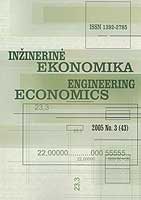Baltic States Business Cycle Symmetry: Shock Correlation Approach
Baltic States Business Cycle Symmetry: Shock Correlation Approach
Author(s): Milda Valentinaitė, Vytautas SnieškaSubject(s): Geography, Regional studies, Supranational / Global Economy, Transformation Period (1990 - 2010), Present Times (2010 - today), EU-Approach / EU-Accession / EU-Development
Published by: Kauno Technologijos Universitetas
Keywords: baltic countries; euro accession; demand and supply shock symmetry; shock correlation;
Summary/Abstract: Paper intends to shed the light on the Baltic States (Lithuania, Latvia and Estonia) business cycle symmetry as compared to selected countries. Structural vector autoregressive model is employed in order to recover the underlying demand and supply shocks and further calculate correlation coefficients. Data for estimation covers ten years period starting with the end of 1993. Bivariate model includes real GDP as a proxy for output and consumer price index as a proxy for prices. Our research is interesting in numerous aspects. First, all new EU countries compulsory must join European monetary union. The Baltic States expressed desire to be among the first entrants and join euro as soon as possible, preferably at the beginning of 2007. However, this might be a risky decision. If these countries will experience asymmetric shocks and subsequently diverging business cycles, grave consequences like output loss and rise in unemployment may arise. Since the Baltic countries are geographically and economically perceived as EU “periphery” we check the hypothesis that their shocks might be uncorrelated with “core” EMU member shocks. Low correlation would suggest that at least currently these countries are not suitable candidates for euro zone. Our estimation indeed discloses troubling signs in this aspect. Symmetry among Baltic States and other EU countries business cycles is low. This finding clearly signals about potential welfare losses arising from asymmetric shocks after euro accession. We find that demand shock correlations with euro area are negative in case of Estonia and Lithuania and very low in case of Latvia. Supply shock correlation with EU is positive for all three countries, but does not exceed 0.5. Estonia has the closest supply shock correlation with individual countries (what might be due to large amounts of foreign direct investment), while Lithuania has the highest correlation with EU “core” and whole euro zone. Second, fixed exchange rate regimes, implemented in Lithuania and Estonia, create auspicious conditions to check the hypothesis about cycle importation from currency anchor country. However, correlation of demand shocks among fixed exchange rate pairs Lithuania-USA and Estonia-Germany is negative. Hence in case of Lithuania and Estonia theoretical prediction of policy importation fails. Third, correlation of demand and supply shocks with major trading partners was calculated in search for business cycle similarities. Hypothesis that trading partners have similar business cycles in most cases is supported by data. Finally, research reveals some specific features of Baltic business cycle. Demand and supply shocks among Lithuania, Latvia, Estonia and Poland in most cases are highly positively correlated. This suggests that some shocks might have been specific to economic reforms undertaken during transition and further development in the region. Demand shock correlation on average is lower than supply shock correlation. This finding goes in line with the results of similar research done on other Central and Eastern European countries. However, we think that increasing trade volumes with EU members and common EMU policies may alleviate the particular problem and force more converging business cycle fluctuations.
Journal: Engineering Economics
- Issue Year: 2005
- Issue No: 4 (44)
- Page Range: 24-30
- Page Count: 7
- Language: English

